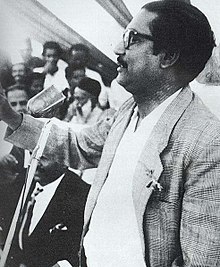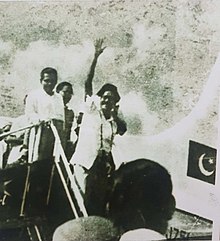| Independence of Bangladesh |
|---|
 |
| Events |
| Organisations |
| Key persons |
| Related |
|
|

The six point movement was a movement in East Pakistan, spearheaded by Sheikh Mujibur Rahman, which called for greater autonomy for East Pakistan.[1][2] The movement's main agenda was to realize the six demands put forward by a coalition of Bengali nationalist political parties in 1966, to end the perceived exploitation of East Pakistan by the West Pakistani rulers.[3] It is considered a milestone on the road to Bangladesh's independence.[4]
Opposition leaders in East Pakistan called for a national conference on 6 February 1966, to assess the trend of post-Tashkent politics. On 4 February, Sheikh Mujibur Rahman, along with some members of the Awami League, reached Lahore to attend the conference. The next day on 5 February, he placed the Six Points before the subject committee and urged to include the issue in the agenda of next day's conference. The proposal was rejected and Sheikh Mujibur Rahman was identified as a separatist. On 6 February, Mujib boycotted the conference. On 21 February, the Six Points proposal was placed before the meeting of the working committee of the Awami League and the proposal was accepted unanimously.[citation needed]
The reason for proposing the Six Points was to give the East greater autonomy in Pakistan. Following the partition of India, the new state of Pakistan came into being. The inhabitants of East Pakistan (later Bangladesh) made up the majority of its population, and exports from East Pakistan (such as jute) were a majority of Pakistan's export income. However, East Pakistanis did not feel they had a proportional share of political power and economic benefits within Pakistan. A statistical overview of economic discrimination:
| Year | Spending on West Pakistan (in crore rupees) | Amount spent on West as percentage of total | Spending on East Pakistan (in crore rupees) | Amount spent on East as percentage of total |
|---|---|---|---|---|
| % of total population | 36.23 | 63.77 | ||
| 1950-55 | 1,129 | 68.31 | 524 | 31.69 |
| 1955-60 | 1,655 | 75.95 | 524 | 24.05 |
| 1960-65 | 3,355 | 70.5 | 1,404 | 29.5 |
| 1965-70 | 5,195 | 70.82 | 2,141 | 29.18 |
| Total | 11,334 | 71.16 | 4,593 | 28.84 |
| Source: Reports of the Advisory Panels for the Fourth Five Year Plan 1970-75, Vol. I, published by the planning commission of Pakistan (quick reference: crore = 107, or 10 million) | ||||
East Pakistan was facing a critical situation after being subjected to continuous discrimination on a regional basis, year after year. As a result, the economists, intelligentsia, and the politicians of East Pakistan started to raise questions about this discrimination, giving rise to the historic six-point movement.[5]
Rehman Sobhan, Nurul Islam, Khairul Kabir, Anisur Rahman, Muzaffar Ahmed Chowdhury, and Khan Sarwar Murshid, and other prominent intellectuals drafted the six-point demand.[6][7]

The six points are noted as being:[3]
The proposal was rejected by politicians from West Pakistan and non Awami League politicians from East Pakistan. It was rejected by the president of the All Pakistan Awami League, Nawabzada Nasarullah Khan. It was also rejected by the National Awami Party, Jamaat-i-Islami, and Nizam-i-Islam.[5] The movement had support from the majority of the population of East Pakistan.[8]